TOKYO -- More than 70 years later, Terumi Tanaka can still relive the havoc wrought on his hometown Nagasaki, which was flattened by a plutonium bomb unleashed from a United States Army Air Forces plane.
At around 11 a.m. on Aug. 9, 1945, Tanaka was at his home some 3.2 kilometers away from the hypocenter of the atomic blast, when he heard a “loud bang” and immediately fell unconscious.
“Everything was instantly blown away in a storm,” the 84-year-old Japanese man told The Korea Herald in Tokyo last week. “I survived because I was lying down on the floor. However, five out of my six relatives died, some instantaneously from the raging inferno, some slowly from putrefying burns.”
Ahead of the international day for the total elimination of nuclear weapons on Sept. 26, designated by the United Nations in 2014, the secretary-general of the Japan Confederation of Atomic and Hydrogen Bomb Sufferers’ Organization, also known as Nihon Hidankyo, warned of the indelible consequences of pursuing nuclear arms and energy.
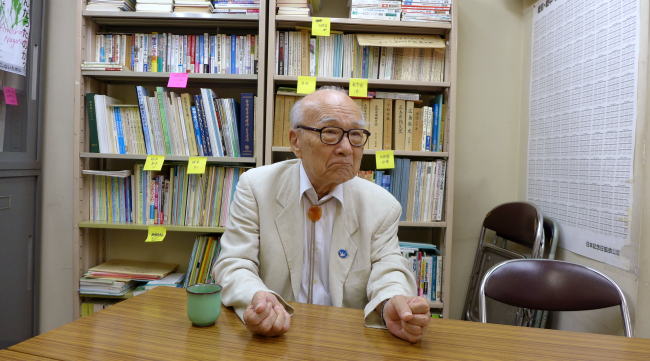 |
Terumi Tanaka, secretary general of the Japan Confederation of Atomic and Hydrogen Bomb Sufferers’ Organization, speaks to The Korea Herald at the organization’s office in Tokyo about the horrors of the atomic bombing he experienced as a child in Nagasaki, Japan, on Aug. 9, 1945. (Joel Lee/The Korea Herald) |
There are more than 15,000 nuclear weapons in the world, with the US and Russia possessing 93 percent of them, according to anti-nuclear organization the Ploughshares Fund. The arsenals are a thousand times more destructive than the bombs dropped on Hiroshima and Nagasaki.
The bombshell dropped on Nagasaki, dubbed “Fat Man,” killed 74,000 people, roughly half the number that had perished from Hiroshima three days earlier. There are currently over 174,000 survivors -- called “hibakusha” in Japanese -- of the apocalyptic events in Japan and several thousands more worldwide.
Along with civic organizations such as Japan NGO Network for Nuclear Weapons Abolition and Peace Boat, Nihon Hidankyo has shepherded anti-nuclear calls around the world since it was established in 1956. It has participated in international conferences, street rallies and speaking tours, urging the total abolition of nuclear weapons, state compensation for their injuries, enhancement of government policies and relief measures, and solidarity with nuclear victims around the globe.
“Japan practically became a colony of the US since the war ended,” Tanaka said. “The US government forbade discussion or research of the bombing for seven years after 1945, and the Japanese government followed suit for an additional three years, thereby doing nothing for 10 years.”
As part of the San Francisco Peace Treaty in 1951, Tokyo renounced its right to claim damages from the nuclear bombardments from Washington. The hibakushas were deprived of their health, disadvantaged in employment and discriminated against by society, according to Nihon Hidankyo.
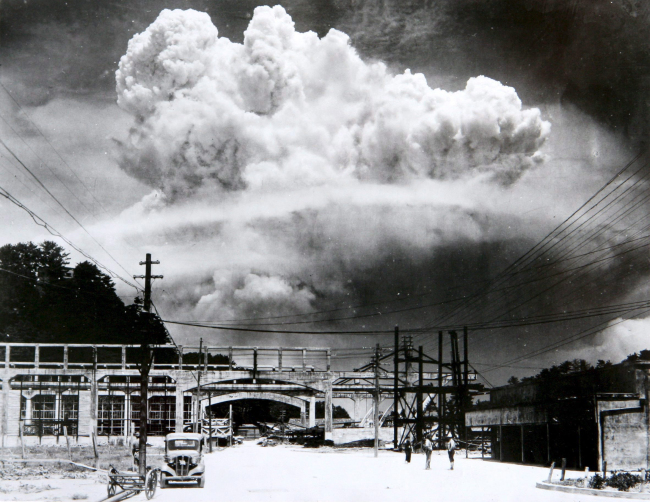 |
A picture taken by Hiromichi Matsuda of the atomic bomb’s mushroom cloud over Nagasaki on Aug. 9, 1945 (Nagasaki Atomic Bomb Museum) |
However, the legacy of Hiroshima and Nagasaki became the subject of national discourse following the radiation exposure and death of Japanese fishermen who were affected by America’s nuclear weapons testing in the Pacific Ocean.
“Life was very tough before 1956, when our government started legislating laws and providing health care to the victims,” Tanaka recalled. “Before that, the sick and dying had to pay for medical expenses out of their own pockets, and many poor people died from malnutrition.”
Tanaka, who lived with a mother and three siblings, had to scrape by working odd jobs and saving pennies for the family as well as schooling. He called it an “unspeakable hardship.”
“We couldn’t eat for days on end. Everyone was poor, and even with little money there was practically nothing we could buy,” he said. “In spite of all our misery, we hoped that things would get better. We survived by shoving whatever was edible into our mouths.”
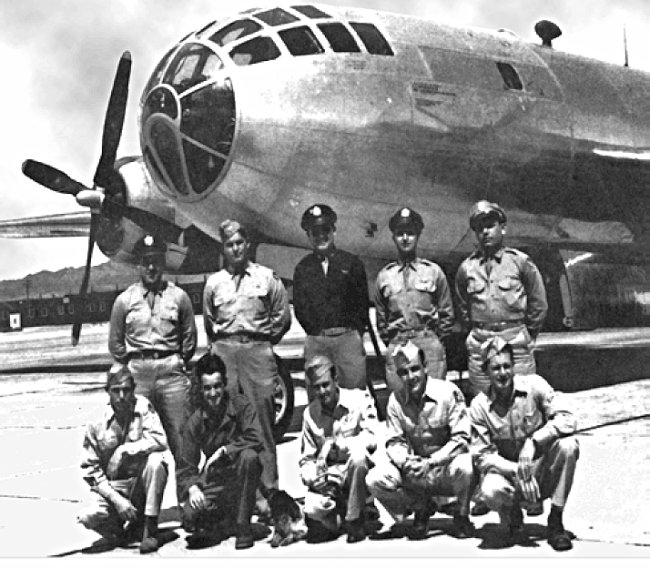 |
US Army Air Force Bockscar plane and its crew, who dropped the "Fat Man" atomic bomb on Nagasaki (Wikipedia) |
In the tragedy’s aftermath, Tanaka noted he did not experience particular health problems, but one of his sisters died from cancer 10 years ago, and several of his acquaintances contracted leukemia and other malignancies. Particularly, many children around age 10 and younger developed cancerous tumors, he pointed out, surmising the bombing was to blame.
While Hiroshima has since become a universal symbol of mass destruction, Nagasaki on Japan’s southwestern island of Kyushu has largely been relegated to the larger city’s shadow. Nagasaki was bombed after Hiroshima, though it was less devastating due to the mountains and valleys of the city.
According to analysts, some 50,000 Koreans are thought to have lived in Hiroshima and 20,000 in Nagasaki during the attack, out of which roughly 30,000 and 10,000 are estimated to have died.
Most of Nagasaki’s Korean victims, who came from Hapcheon County in South Gyeongsang Province, were forcibly conscripted for backbreaking labor in wartime factories. The survivors returned home after the war to establish an organization similar to Nihon Hidankyo, with which the Japanese side maintains close contact.
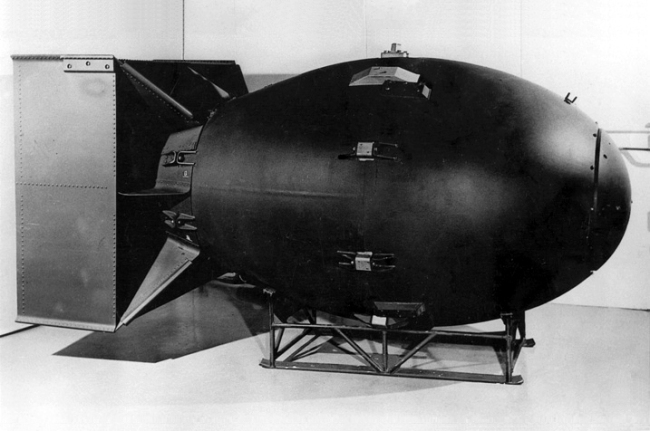 |
A mockup of the "Fat Man" nuclear device (U.S. Department of Defense) |
“Japan believed peaceful use of nuclear energy was possible and should be welcomed,” Tanaka said, referring to the country’s postwar embrace of civilian atomic energy, which was birthed in 1954 as a government program.
“We were worried about accidents such as the Chernobyl nuclear disaster in 1986, but thought they would not be repeated in our country, which prided itself on technological precision.”
Following the Fukushima Dai-ichi nuclear catastrophe in 2011, he stressed, anti-nuclear voices have grown stronger based on recognition that Japan -- as a country located on an earthquake fault line and in a volcanic zone -- cannot guarantee the absolute safety of its nuclear power.
“The destruction from a nuclear disaster is not limited to one country, but affects the whole world,” Tanaka emphasized. “Residents near the Fukushima Dai-ichi nuclear power plant are following a similar course as Hiroshima and Nagasaki victims. It is critical to probe and minimize their sufferings.”
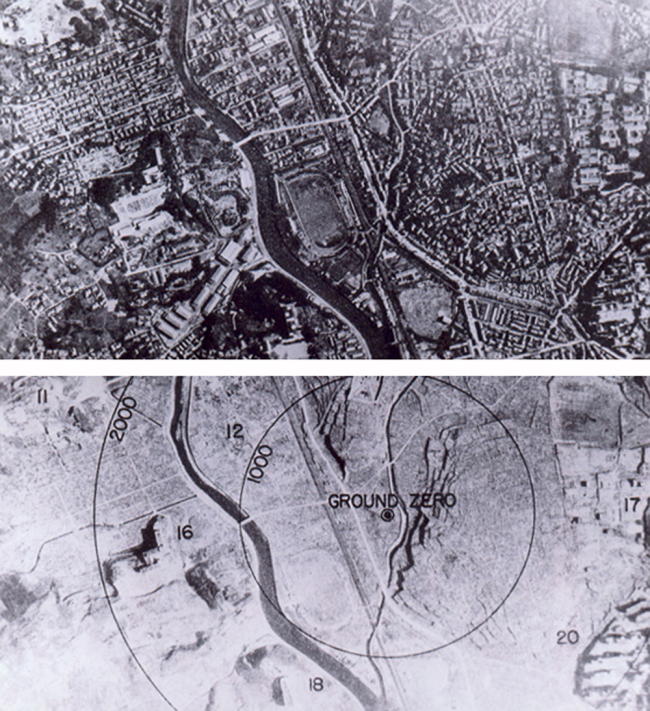 |
Nagasaki, Japan, before and after the atomic bombing on August 9, 1945 (U.S. National Archives) |
Regarding North Korea’s nuclear tests and missile provocations, the elderly man underlined that his organization had firmly opposed them. Nihon Hidankyo has expressed support for the six-party talks for the denuclearization of North Korea and made efforts to establish a nuclear-free zone in East Asia, he added.
“But Tokyo has actively inflamed public fears of Pyongyang’s threats and forged ahead with policies strengthening security ties with Washington,” he claimed, noting the Japanese people have felt “emotionally frightened” by the government’s approach.
“I believe Japan must also consider peaceful diplomacy with North Korea,” Tanaka argued. “As a personal opinion, a peace treaty between Pyongyang and Washington could stabilize the situation.”
On relations with South Korea, he asserted that Japan -- both a casualty of history as well as aggressor -- has the moral responsibility to offer the olive branch.
“Colonial Japan had caused great harm and suffering on the peoples of Asia throughout the first part of the 20th century,” he contended. “We should never forget this part of our history. However, the younger generations aren’t well aware of the past due to our government’s lukewarm attitude and our education’s passive, pacifist curriculum.”
Highlighting the importance of contrition through education, the secretary-general also advised Korea not to perceive the whole of Japan in a negative light.
“The government or policy could be overly nationalistic, but this doesn’t mean that all Japanese people are on board with it,” he said.
‘Civil-military nuclear industrial complex’
In an email interview with The Korea Herald from Hiroshima, professor Robert Jacobs of the Hiroshima Peace Institute at the Hiroshima City University said that “civil nuclear energy and military-security interests are inseparable.”
“Nuclear power plants were initially invented to produce plutonium for nuclear weapons,” he said, adding that 12 years passed before they started generating electricity.
In Japan, operating them has enabled stockpiling large quantities of plutonium, which can be used for military purposes. Japan is the only nonnuclear weapons state out of the six countries capable of producing plutonium from uranium.
Jacobs said that Tokyo has clung to nuclear energy to sell its atomic technologies abroad and to prop up the value of utility companies that have invested heavily in the industry.
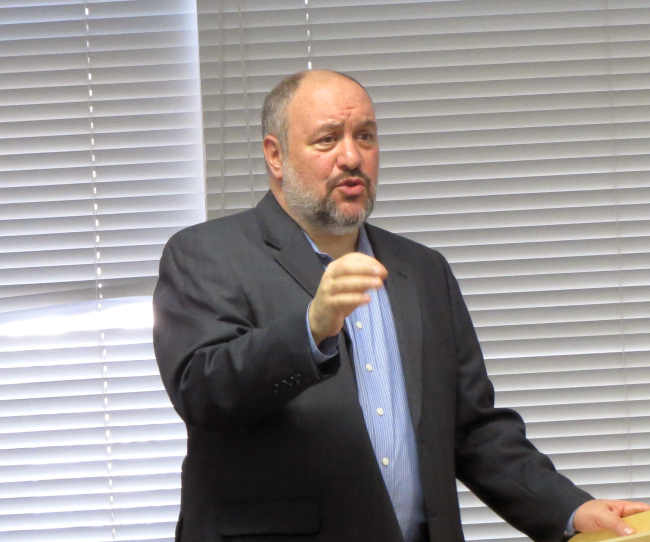 |
Professor Robert Jacobs of the Hiroshima Peace Institute at Hiroshima City University (Robert Jacobs) |
“A clear majority of the Japanese public opposes the continued use of nuclear power in the country,” he stressed, citing people’s concerns following Fukushima.
All 53 nuclear power plants in Japan were closed down after the 2011 debacle, but they are resuming operations. Jacobs argued that this was being done little by little to “dilute” nationwide public outcry.
They are also turned on “as far from Tokyo as possible” to keep the protests away from the capital, he said.
Currently, three nuclear reactors at Sendai 1, Sendai 2 and Ikata 3 are running, and an application to reactivate 22 additional reactors has been filed.
The post-disaster management of Fukushima -- in terms of environmental cleanup, health care provision, reparations for and relocation of displaced persons and decontamination of affected areas -- has been “very poor,” Jacobs argued.
The government has focused on minimizing the cost of damage control and managing public opinion, he alleged, adding that people have been allowed to re-enter contaminated areas.
“This is done primarily to terminate payment to them for their forced evacuation,” the professor asserted. “Many people lost the vitality of their businesses and property values. They will receive no compensation for such losses.”
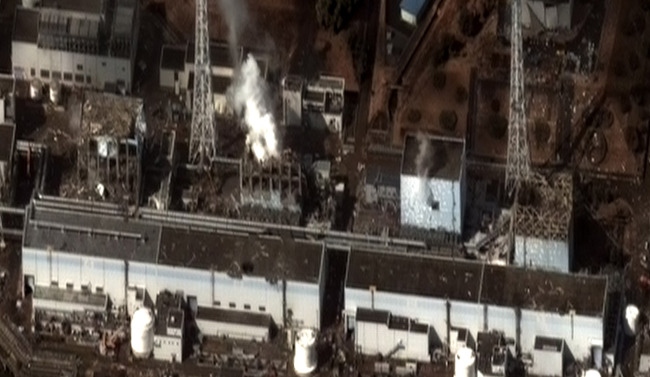 |
The Fukushima I Nuclear Power Plant after the 2011 Tohoku earthquake and tsunami. From left to right are reactors 1 to 4 (Digital Globe) |
Of grave concern, children have been diagnosed with thyroid cancer at rates higher than before the calamity, he pointed out. “Trust in the government is very low.”
Regarding the radioactive contamination, Jacobs said that radioactive particles -- including cesium 137, strontium 90 and tritium that were released from three of the exploded reactors and are harmful to biological life -- will long remain in the ecosystem. Out of these, cesium 137 is the most hazardous and longest lasting, according to experts.
There has been a widespread contamination of forests and mountains surrounding the plant, the scholar said. Despite the removal of polluted topsoil across vast areas, wind and rain will spread and trickle radionuclides down to the towns, he projected. He also said the removed soil that has been collected in plastic bags will eventually re-enter the ecosystem, as the radioactivity will outlast the plastic bags.
“It is highly irresponsible to use nuclear energy in a country with frequent earthquakes,” the professor contended. “As we have witnessed in Fukushima, it is impossible to perfectly engineer for all possible disasters. In the event of a meltdown, the financial gains accrued from operating a power plant can be wiped out in repairing the damage.”
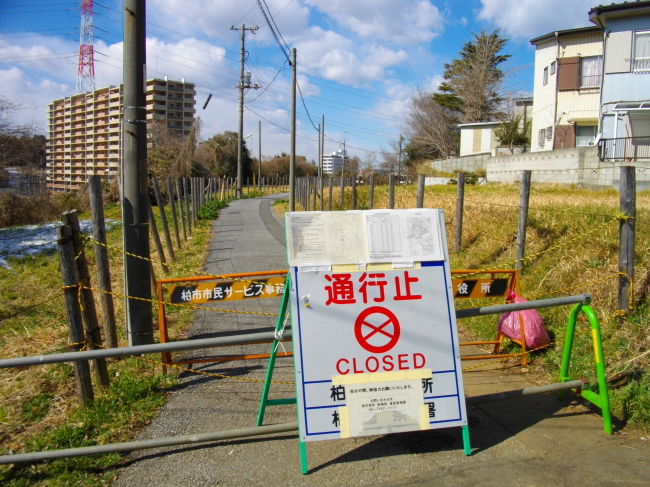 |
A radiation hotspot in Kashiwa (Abasaa) |
Mentioning that the toxic nuclear waste must be sealed off underground for over 100,000 years, Jacobs emphasized that “nuclear energy is unfeasible with peaceful, equitable and sustainable development.”
“No society can confidently claim it is protecting its future generations from the danger of nuclear power,” he said. “Nuclear energy creates liabilities that last for thousands of generations. Spent nuclear fuel will remain poisonous for hundreds of thousands of years.”
Pointing to renewable energy as an “inevitable solution,” he added that “Japan is in a very good position to be a leader in this essential technology.”
By Joel Lee, Korea Herald Correspondent (
joel@heraldcorp.com)
Hiroki Akamoto and Nara Lim contributed to this article through interpretation and translation. -- Ed.















